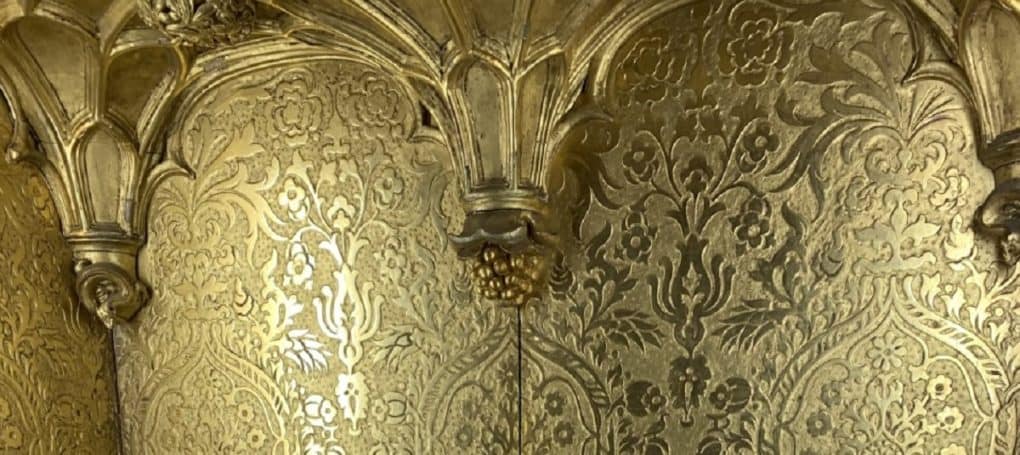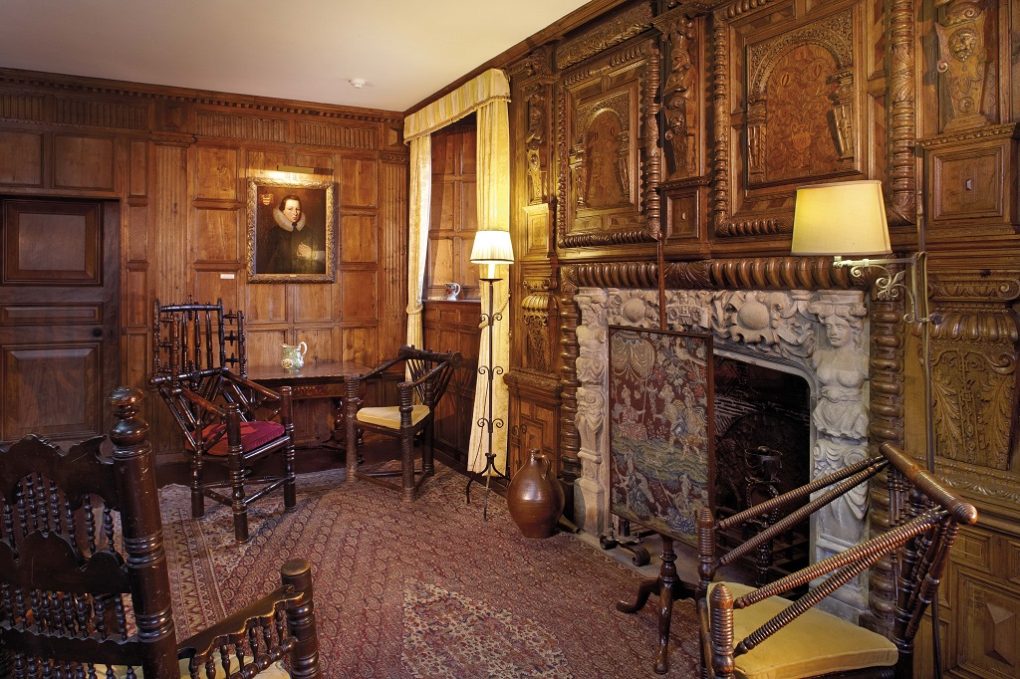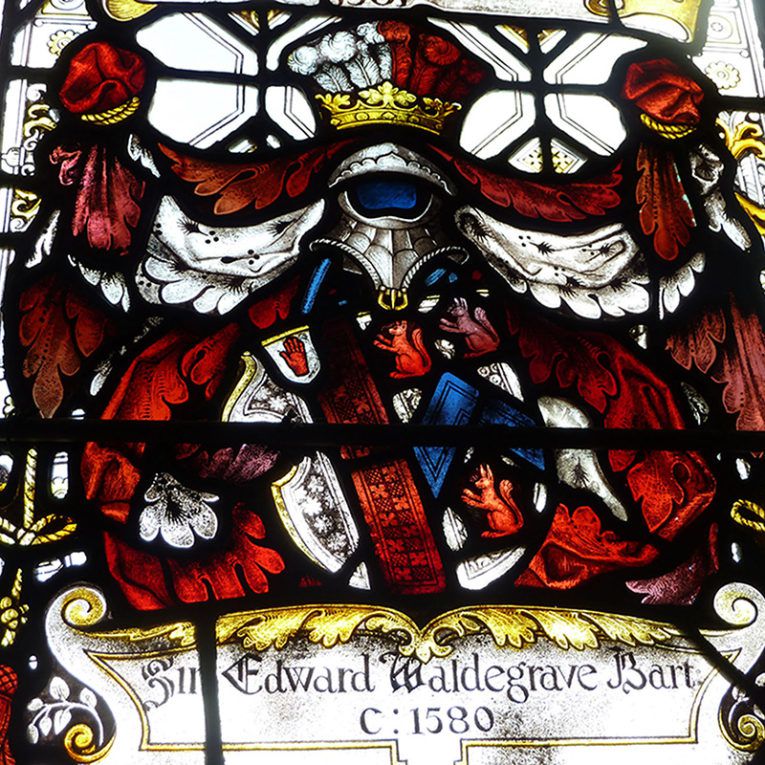
 PRIEST HOLES – FEATURE FRIDAYS
PRIEST HOLES – FEATURE FRIDAYSThe theme for this week’s #FeatureFridays with Historic Houses is priest holes, by Dr Owen Emmerson.
On this Feature Friday, we take a look at priest holes and persecution and how Anne Boleyn reshaped England’s religion and consequently reshaped the Castle she once called home.
In the corner of Hever Castle’s Morning Room is a brightly gilded cupboard which hides a dark chapter in Hever’s history. Now a golden cabinet displaying fine china, this space is traditionally believed to be a priest hole: a hiding place for priests which were built or adapted into many of the Catholic houses of England during the period when they were persecuted by law. One such family lived at Hever Castle – the Waldegrave family – and Sir Edward Waldegrave would be the third of Hever’s inhabitants to end his days in the fearsome Tower of London. This priest hole was likely used during the Waldegrave tenure of Hever when the family were persecuted by their beliefs under Queen Elizabeth I.

Before the Waldegrave family purchased Hever, it was the home of the famous Boleyn family; some of whom were renowned for their radical religious views. When Henry VIII courted Anne Boleyn and found that the Pope would not grant an annulment from his marriage to Catherine of Aragon, it was Anne Boleyn who directed the King to the works of William Tyndale to aid his ‘Great Matter.’ Though deemed heretical at the time, Anne introduced Henry to a copy of Tyndale’s “The Obedience of the Christian Man,” which espoused that Kings were accountable only to God, and not to the Pope. Henry reportedly stated that “this book is for me and all Kings to read.” Henry would go on to break with Rome and make himself the Supreme Head of his Church to marry Anne Boleyn. Henry VIII may have remained a traditional Catholic, but his three children did not follow suit.
Henry’s longed-for male heir, Edward VI, reformed his father’s ostensibly Catholic Church to an institutionally Protestant one. It was during Edward VI’s reign in 1551 that Edward Waldegrave – who was a member of Edward VI’s sister Mary’s household – was first arrested and imprisoned in the Tower of London for his Catholic beliefs. Waldegrave was a recusant Catholic and refused to carry out King Edward’s ban on hearing Mass in Mary’s household of Copt Hall in Essex.

Waldegrave was released from the Tower when Edward VI died, and Mary I ascended to the throne in 1553. Under Mary, the country underwent a Counter-Reformation, returning England to the Catholic faith and the authority of Rome. Edward Waldegrave flourished during this period. Mary knighted him and placed him on her Privy Council. She also sold to him Hever Castle, which had remained the property of the Crown since Henry VIII had purchased it in 1540. Mary is perhaps best remembered for the purges of Protestants throughout her reign when over 300 religious dissenters were burned at the stake, known as the Marian persecutions. Like that of her brother before her, Mary’s reign was short, and she was unable to provide an heir. Her successor, Anne Boleyn’s daughter Elizabeth I, was arguably just as culpable of religious intolerance, killing over 200 Catholics during her reign. But history is written by the ‘victors’, and the famous “Book of Martyrs” by John Fox which documented Mary’s persecutions in 1563 was a potent bestseller that helped to differentiate “Bloody Mary’s” persecutions from those of “Good Queen Bess.”
During Elizabeth’s reign, Catholics had to grow adept at concealment, creating spaces within their houses to hide a priest should the authorities come looking. Celebrating Mass had been made illegal by the Act of Uniformity in 1559, and Elizabeth punished those who trained or harboured priests as traitors and not heretics. Those who fell foul of the law faced not the flames but potentially the traitor’s death of hanging, drawing, and quartering. Sir Edward Waldegrave’s short respite from persecution was shattered in 1561 when he was arrested in conjunction with a spurious conspiracy, known as the ‘Waldegrave Conspiracy.’
Custom’s officials at Gravesend had seized Waldegrave’s priest, Father John Coxe, who was found with a rosary and letters for Catholic exiles. After interrogation, Sir Edward Waldegrave was named as one of many for whom Coxe had said Mass. Sir Edward Waldegrave was arrested with twenty-two other lay Catholics who were implicated by the confession that Coxe gave, and all were found guilty before the Essex Assize Court on 3rd June 1561. The lay Catholics were ordered to pay a fine of 100 marks – approximately £15,000 in today’s money. Sir Edward Waldegrave refused to pay the fine and he and his wife Frances were taken back to the Tower of London. He did not last long, dying in his cell on 1st September 1561. Frances was released from the Tower upon his death but similarly refused to pay the fine, forfeiting Edward’s manor of Newhall in Essex.
It appears that the mastermind behind the ‘Waldegrave Conspiracy’ was William Cecil, the Queen’s chief advisor, who was determined to prevent Elizabeth from marrying Robert Dudley. He feared that although a Protestant, Dudley would seek support for his marriage from King Philip of Spain and risk conditions laid down on Philip’s part that would return England to Catholicism. Rumours that those accused with Waldegrave were conspiring to kill the Queen created sufficient furore of a Catholic conspiracy to ensure that any marriage plans were thwarted. It is perhaps in this context that the priests accused were only corporally punished – being pilloried twice and then imprisoned – and not subject to capital punishment.
It appears that the Waldegrave family spent little time at Hever Castle for the rest of the nearly 150 years that they owned it, choosing to rent it out for income. It is, perhaps, for this reason, that so much of the Boleyn’s original family home remains intact for visitors to experience today, with tenants unwilling to expend funds to modernise a property that they did not own. Hever Castle, and its most famous occupant Anne Boleyn, was at the centre of a religious and political schism that would influence not only the religious turmoil that came in the wake of her short reign, but that would shape the very fabric of the castle Anne once called home. The priest hole at Hever Castle is a reminder of that legacy; a surviving physical alteration which tells us something of the seismic religious, political, and cultural shifts that followed Anne Boleyn’s unlikely elevation to Queen consort.
If you enjoyed this item on Priest Holes then why not discover the previous #FeatureFridays news items:
Book your visit to Hever Castle & Gardens.
Within the grounds of the Hever Castle Estate, there are two opportunities for you to stay the night with us.
Hever Castle has played host to many important events and celebrations for over 600 years. In 1903 when William Waldorf Astor set about restoring Hever Castle to its former glory, he added the Astor Wing, to accommodate his family and guests, before creating a lake and the spectacular Italian Garden to house his impressive collection of ancient Greek and Roman statuary.
There are multiple places to eat & drink across the Hever Castle Estate. Select between the Castle & Gardens and Golf Club below to discover more.
Set in the mature grounds of the Hever Castle Estate, Hever Castle Golf Club is a 27 hole Kent golf course that will encourage and inspire all golf enthusiasts.
Set in the mature grounds of the Hever Castle Estate, the Wellbeing Centre consists of five smart treatment rooms.